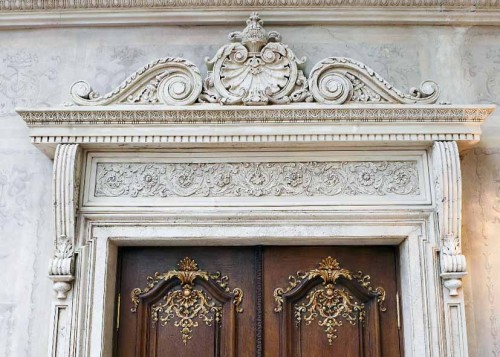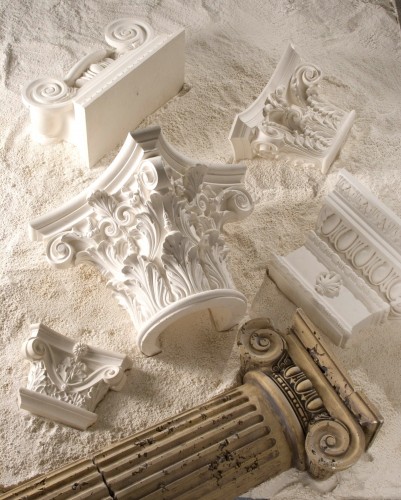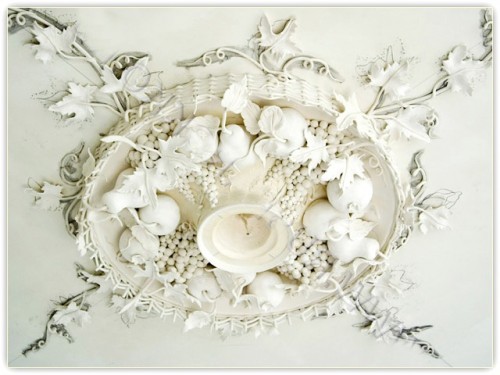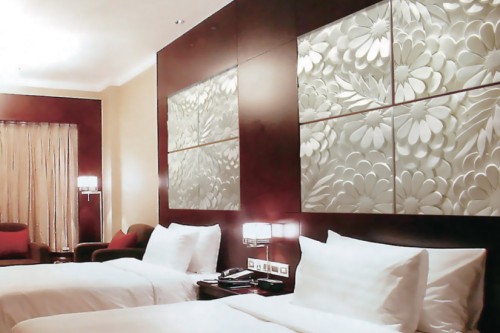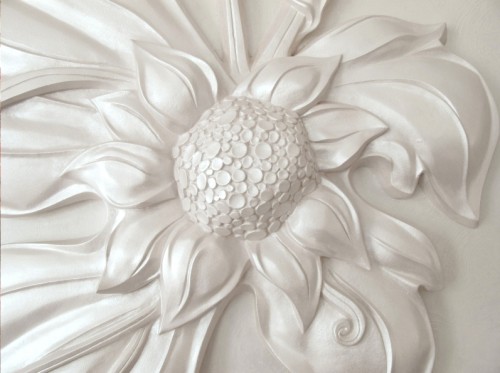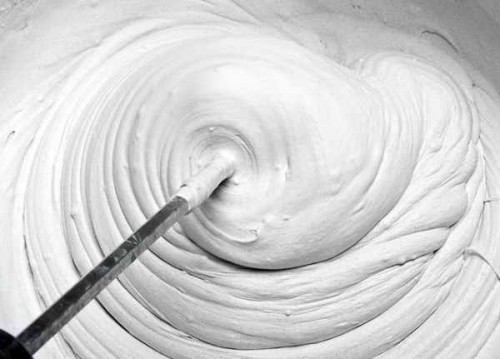
How to restore gypsum leptin Useful advice,Walls
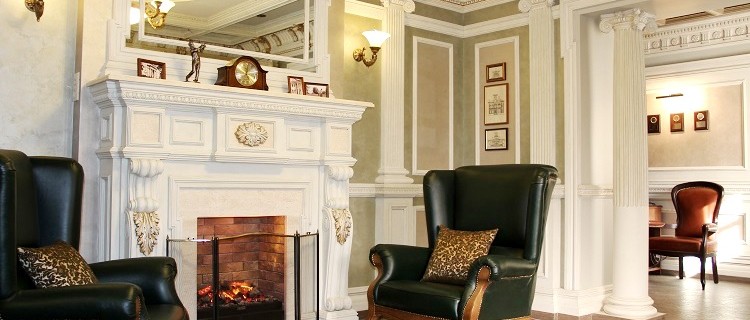
Gypsum stucco in the interior is a fairly common way to decorate the room, which is capable of bringing a classic style and originality in the room design. This is a unique tool that will allow you to decorate the inner decoration of the room without labor-intensive construction work. A wide variety of embossed patterns, shapes and drawings will harmoniously fit into any interior.
Content
Features of the material
Gypsum stucco is a bulk embossed decoration, which is used for internal and external decoration of buildings. This material is characterized by environmental safety, since it is made of natural raw materials - a mixture of dust gypsum stone and water. Also gypsum material is fireproof. Among other merits, it is possible to distinguish such as:
- clarity forms and lines of relief;
- environmental friendliness;
- bioscistance;
- strength;
- lack of shrinkage;
- versatility of use;
- the possibility of restoration of decorative elements as a result of their damage.
As a lack of plaster, its hygroscopic properties can be distinguished, but this problem can be solved by using special formulations for impregnation. In addition, the gypsum is a rather fragile material.
Application of gypsum in decorative trim
Gypsum is suitable for creating stucco due to its characteristic properties. This material penetrates well into the smallest cracks and embossed forms, due to which the high accuracy and accuracy of the product is achieved. To reduce the charges of plaster, it is necessary to breed on lime water, which in turn should be prepared on the basis of a quenching and negated lime.
The area of \u200b\u200bapplication of plaster stucco is to decorate the ceiling, walls and niches. But in the last period, the scope of using the gypsum decor has become much wider. Consider the main areas of using plaster stucco products:
- With this material, it is possible to divide the room into separate zones by making decorative partitions.
- Pretty spectacular stucco looks on buildings facades. Such a decor can hold out several hundred years, therefore, due to their durability, gypsum facades are highly popular. At the same time, the restoration of the stucco will not hit the budget and the product it will be easy to return the original look.
- Gypsum stucco looks harmoniously on the finish of the fireplace, giving it an aristocratic style and originality.
- In addition, such decorations are often used to design window or door openings.
- The use of stucco elements on the walls will allow to hide some disadvantages of the interior or adjust the surface of the walls.
However, over time, cracks appear on the stucco, chips, which ultimately leads to its destruction. Such an outcome can be prevented by performing the restoration of the stucco. You can restore the decorative elements yourself, while saving financial resources and showing your own creative abilities. Restoration implies a complete restoration of the initial finish type. At the same time, during the work, you need to pay attention to the fact that the boundaries between the former and created elements are as soon as possible.
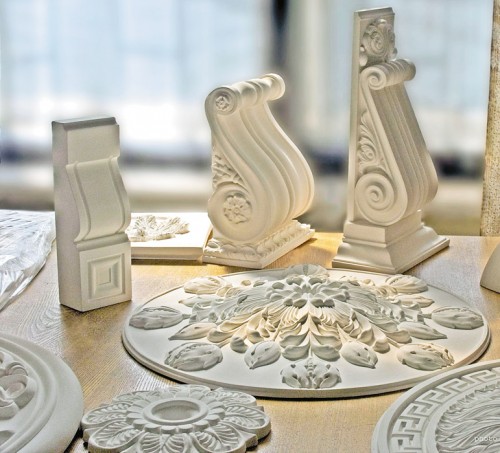
Recommendations for restoration behavior
The stucco, made of plaster material, is quite well reconstructed. At the same time, such recommendations should be taken into account on the restoration of stucco fragments:
- In case of insignificant damage, it is not necessary to replace parts, it is enough to restore the formed chips at the places of existing elements.
- Gypsum if desired, you can paint in any color. It is preferable to use the paint of a water-soluble or emulsion type for this.
- Also on stucco fragments you can make an artistic painting. To do this, it is recommended to use soluble or oil paints.
- Before starting work, it is necessary to carefully examine the nature of damage to the decorative element and think over the most accurate way to reconstruct.
- In case of substantial damage to the stucco, its initial species should be restored by photographs if they are available.
- In case the destruction is partial in nature, the finish should be restored by intact fragments.
- If there is a layer of paint on the surface of the product, it must be considered to fully obtain an idea of \u200b\u200bthe existing defects.
- To restore the stucco, cracks and the seams should be calculated to re-fill them with plaster.
- Destroyed fragments need to be removed, and cleaned the locations. The elements of the finishes that hold weakly should be re-fixed. After these events, stucco is ready for the restoration process.
- In the event that a certain fragment of the finish is not subject to recovery, and there are no photos with its image in stock, you should make a detail of the corresponding shared finish style.
- Then the damaged elements are restored, gluing them and add made parts.
- Finishing surface is processed.
Methods of restoration of gypsum decor
The first method of restoration of the stucco lies in the casting of missing fragments, focusing on the preserved details of the finish. In accordance with this recovery technique, it is originally necessary to inspect the available stucked parts and select the genuine element. It will serve as a model for restoration. Also, this method includes repairing stucco fragments aimed at removing from the surface of the existing defects. After that, the manufacture and processing of the new element occurs.
The second method involves the implementation of the rubber of the relief sites that have lost their clarity. Such a defective change usually occurs when removing adhesive or lime painting. Restoration work implies the study of the surface of the stucco, the preparation of the necessary solution and the processing of damage places. Then the drawstage is then carried out.
Restoration process
Restore defects on plaster stucco are absolutely not difficult, since it is not necessary to have special skills. It is enough just to know several fundamental moments. Consider more detailed every stage of restoration work.
Preparation of the surface to restore
- At the initial stage of the restoration of plaster stucco, it is necessary to clean the surface of the gypsum decor from contaminants.
- Then you should remove all emulsion, glue, oil and varnish layers. To perform this task, you need to apply a thick consistency in the gypsum surface, which should be removed from the drying field.
- As a result of the work done, stucco parts will not be to expose moisture or mechanical damage. This manipulation must be performed in order to obtain the maximum idea of \u200b\u200bthe original relief and the pattern of stucco.
- Next, we carefully select and glue the existing fragments in order to maximize the use of genuine elements when restoring the decor.
- For the restoration of the connecting elements, dissolved thermoplastic should be applied.
- After the surplus of the gypsum material, it is necessary to squeeze and remove with a blade or knife.
- At the next stage, there are missing details. You can also recreate integer elements of the pattern after the selection and gluing individual fragments.
- To cast missing parts, it is necessary to prepare artistic plasticine and silicone lubricant. Thanks to its use, the finished product can be easily separated from the plasticine form.
- Plasticine should be well to develop before purchasing a soft consistency and give it the form of bar.
- Then a sharp movement should be pressed into the plasticine the preserved element of the stucco.
- After the form, we turn over and remove a gypsum fragment from it.
- To ensure the quality of work, you should pay attention to the fact that the relief shape is clear.
- Next, we lubricate the form of silicone lubrication and pour into it a solution of plaster.
Preparation of gypsum solution
Gypsum solution is prepare as follows:
- In dry gypsum add hot water. This is necessary in order to speed up the process of solidification of the composition.
- Next to the mixture, add water-based adhesive. It can be a standard PVA.
- As a result of adding to the glue composition solution, the process of frost will occur much faster, and the surface of the stucco will be stronger. Also, the surface treated with a solution with a glue content is less susceptible to the occurrence of cracks in the future.
- In order for the product to give more strength to also add a small amount of cement to this mixture.
- The facial surface of the shape with the pouring should be evenly missed with a brush. It must be done in order to remove air bubbles. Otherwise, over time, bubbles will cause cracks.
- After filling out the shape with a spatula, align the surface.
- Ready fragment remove from the form.
- In the next, we carry out the processing of the surface of the gypsum decor. To do this, with the help of plaster fill the cracks, chips, cracks and places of defects.
- With the help of chemical composition, we strengthen the gypsum parts, which collapsed as a result of removal of rusty spots, as well as leaks.
- Repair of stucco is completed.
Painting stucco
Gypsum stucco has a white surface, but if desired, its color can be changed. It is important to remember the following points:
- The paint is better to choose an identical one that was used for staining walls.
- If the stucco decor was not covered with varnish, before the process, painting need to be primed in two layers.
- You should also divide paint with water and stirred it carefully.
- To apply paint on the surface of the stucco, it is recommended to use a small brush with a long pile.
- You can also use pieces of fabric or sponge to give the surface of natural texture.
- If you wish, you can create a different gilding or loss, thus performing the imitation of the "Time Waters".
Plaster stucco today is a popular way of decor for interior design and buildings exterior. It is able to give the usual smooth monotonous walls of notes of originality and diversity, noticeably by the transformation appearance of the room.
Written with your hands video:




